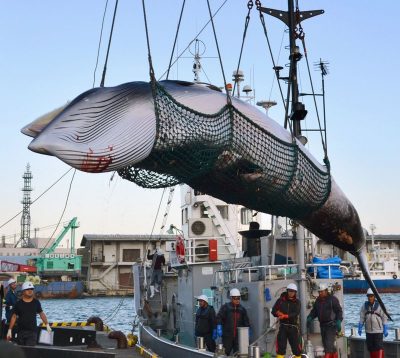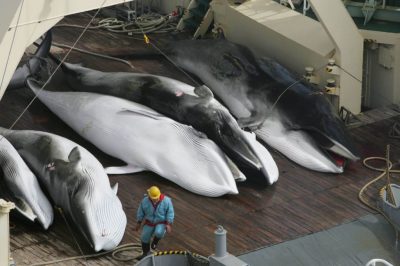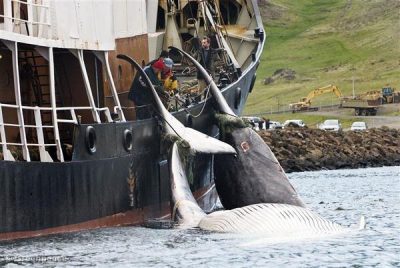Is Commercial Whaling Necessary? History, Facts and Myth of Whaling
This blog post provides basic knowledge about whaling and the reasons for anti-whaling. At the end of the post, the author expressed his understanding of the act of whaling, but he did not believe that the act of whaling was necessarily in Japan’s interest and took the opposite position.

Source: WWF
Withdrawal from International Whale Commission (IWC) and resumption of commercial whaling of Japan within Exclusive Economic Zone on 1st July 2019 had attracted comprehensive press coverage on a global scale. International media mostly criticized Japan’s decision which withdrew from the international commission and resumption of commercial whaling, but some press evaluated positively regarding the withdrawal from the Atlantic ocean. Through reading several articles, I found that there are some gaps and differences of perceptions between Japanese media and international media. This article aims to explain some questions about whaling issues from both perspectives, Japanese viewpoint and global viewpoint.
*What is IWC?
The International Whaling Commission was established in 1948 under the mission to “promote the proper preservation of whales and to enable the orderly development of the whaling industry”. It was established based on the International Convention for the Regulation of Whaling in 1946, with 88 countries participating.
IWC’s moratorium, which regulates commercial whaling, is not legally binding, so some countries who object to it, Norway and Iceland, still conduct commercial whaling.

(Source- IWC)
The reason why I am interested in whaling
The author of this article is Japanese. I was born and grew up in Japan until the age of 18. I am proud to be Japanese.
Since I was a child, I’ve seen many people who eat whales in restaurants. But commercial whaling was already banned when I was in Japan, so there was not a lot of whale meat in markets. Therefore I consider that a whale is a kind of mammal species and also it is an edible animal same as fishes or livestock.
One day, I found a comment which seemed to be posted by a foreigner when I watched a video on YouTube, which introduces Japan’s sightseeing spots.
It says that;
” Such barbaric people! Japanese enjoy killing whales brutally. Murderers! I hate Japan!”.
That was shocking for me. I knew that commercial whaling is criticized internationally, but I thought Japanese eat whale the same as beef, chicken, or fishes. But why are there discriminations about our culture and nationality?
However, I realized that I didn’t know issues about whaling such as the historical background, the reasons for criticism, or the difference of perspectives between Japan and the international. So, I decided to take this opportunity to learn about it.
That is the reason that I am interested in whaling.
What is “Commercial Whaling?”
Commercial whaling is an act to hunt whales for selling their meat, oil and blubber. It has a long history and is always along with human development.
For a long time, whaling has been practised around the world. In the oldest history, whaling began in Norway, France, and Spain in the 9th century. Afterwards, modern whaling, which mainly seeks efficiency for whaling methods and humane approaches, started in the United States in 1712 (so-called the American style). Since that time, the efficient system has spread around the world, until the early 1900s.
In the 1900s, the increase of demands for whale oil made people catch more and more whales and consequently, the depletion of the whales became a concern in the whole world. In the 1960s, some countries, such as the United States, the United Kingdom, the Netherlands, and Australia, began to withdraw from whaling after the establishment of IWC. At this time, the world standard became anti-whaling, and eventually, the IWC adopted a moratorium which banned commercial whaling in 1986.
Until now, whaling is opposed not only by the IWC but also by many governments and private organizations.
History of Whaling in Japan
The history of whaling in Japan is long, and the earliest evidence that equipment used 6,000 years ago for whaling capture. Whaling is said to have begun in earnest in the 12th century, and it became widespread throughout the country in the late 17th century.
After the defeat in World War II, Japan plunged into a massive food crisis. While the country was recovering from the war with little distribution of meat and vegetables, whale meat was a valuable source of protein that was widely consumed by the Japanese people. In the 1980s, became a growing nation, the culture of eating whales was still there, but the whale hunting for commercial purposes was stopped after 1987 due to protests by countries that were against whaling. After that, whaling for ecological research purposes continued, but the complaints from anti-whaling countries were fierce, and demands for improvements and discussions with the IWC were often rejected. As a result, in 2018 Japan notified the IWC that it was withdrawing from the IWC and in June 2019 it officially withdrew from the IWC.
Why has Japan started commercial whaling again?
Currently, some countries in the world are engaged in whaling; besides Japan, Ireland, Norway, Russia, the United States, Canada, and Indonesia are among them (Japan Whaling Association, 2020).
Also, out of the 88 member countries of the IWC, 40 countries support the sustainable use of whaling (IWC, 2020), so in fact, not all countries in the world are opposed to it and can be said to be indifferent to it.
Japan left the IWC for the reason that the organisation has not come up with sustainable commercial whaling and Japan wants to resume whale hunts. Japan has been hunting and eating whales for many years, so for Japanese, eating whales is part of their long-history culture. Although people eat less volume of a whale from before, Japan believes the resumes of whaling makes the thriving of culture.
The Australian government officially announced that the withdrawal from IWC and resume commercial whaling in Japan was “extremely disappointing”. Foreign Minister Marise Payne and Environment Minister Melissa Price state;
“The IWC plays a crucial role in international cooperation on whale conservation. [Japan’s] decision to withdraw is regrettable, and Australia urges Japan to return to the convention and commission as a matter of priority”
(Australian Embassy in Tokyo, 2nd July 2019 ).
Despite offers from Australia as well as other anti-whaling countries, the Japanese government does not appear to be willing to return to the IWC at this time.

(source: uk.whale.org)
True or False? Reasons for anti-whaling
So, let’s take another look at why the anti-whaling countries are opposed to whaling.
There are common three main reasons why anti-whaling groups oppose commercial whaling as follows;
- Whales are threatened for extinction
This is the most common reason people protest on commercial whaling. They say that whales become an endangered species because of commercial whaling. People claim that the resumption of commercial whaling will eradicate whole whales from the earth.
However, I would say this is the wrong opinion. There is a history that not all, only a part of species are threatened to extinction by the commercial whaling industry to produce whale oil was flourishing, and the resource management system was not fully established. As a result, the anti-whaling movement emerged around 1970 in developed countries, mainly in Europe and the U.S., under the slogan of “Save The Whales”. For today, whaling is only conducted for research purposes, and the system and resource management completed internationally, so whales cannot become extinct under the current whaling system.
Also, this “Save the Whale” slogan has a built-in gimmick: by adding “the” before the word “whale,” gives an impression that all whales are in danger of becoming extinct again. In fact, according to the Fisheries Agency in Japan explains that there are over 80 species of whales in the world, and only two species are endangered, such as Balaenoptera musculus and Balaenoptera physalus. Conversely, there are some species of whales that have increased since the ban on commercial whaling, such as the Antarctic black minke whale, numbering over half a million. Indeed, the use of the word “endangered” in media given the impression which the whales as a whole are endangered. The agency explained that the increase in certain species destroys the current ecosystem. Japan’s commercial whaling takes minke whales within the scope of research and management, so there is no possibility of their extinction by commercial whaling (Fisheries Agency, 2020).
- There’s no reason why we should eat whales
Some people claim that “We don’t need to eat whales because we’ve got livestock and fishes”.
Three key points could be considered;
- First of all, the sustainable use of marine resources is allowed in international law, but the current situation is a contradiction in terms, as we are unable to access whales, which are a sustainable resource. As aforementioned earlier, whales have more than 80 species, and commercial whales access only certain species which are not faced to extinction.
- Secondly, food is not the same as what we eat as long as the quantity is sufficient. Peoples around the world have developed and maintained their own food culture based on their living environment, nature and history. Catching and eating whales is an integral part of the culture of those who have such a diet.
- Third, as I mentioned above, studies have suggested that the increase in cetaceans due to overprotection may be harming other fishery resources. Overprotection of certain species could upset the balance of marine ecosystems and affect other fishery resources we eat.
- Enjoy the brutality and carnage of the way the whales are caught and killed
This is also a common opinion. If you search “whaling”, it is easy to find some pictures of whales bleeding, and it seems brutal. However, efforts are always made to increase the instantaneous death rate of the whales for humane considerations. In the past, people used to hunt whales with electric forests, but now they use explosive harpoons and guns to ensure that the killings are as short as possible. This is the “most humane” method approved by the IWC; the whale is killed instantly or in less than two minutes, far less time than any other wildlife species.

(source: Greenpeace)
Summary and Personal Opinion
I’ve discussed the history, facts, and opinions on whaling, but simply put; there seems to be a lack of communication between the two sides, anti-whaling countries and whaling countries as follows;
- The Perspective of Endangerment
- Many people claim for the extinction of whales, but it seems only limited people can explain how much and which species are explicitly facing extinction. This is a stereotype that is created by the media, which portrays all whales facing extinction.
As a matter of fact, it should consider how many and which species of whale are hunted before discussing the issue.
- The Perspective of Culture
- The biggest reason that Japan wanted to resume commercial whaling is to protect one’s culture. It is not a single-time boom, Japan has a long history of eating whales for a thousand years. We need to continue to discuss this because it is difficult to change our dietary habits within a culture.
I’ve said a lot about whaling so far. Personally, through learning about whaling issues, I feel that whaling is not necessary for Japan.
But please do not misunderstand, I don’t have a negative impression of eating whales or commercial whaling itself. I’ve read a lot of research papers and clearly know that commercial whaling will not extinct whales.
However, I don’t think there are many benefits for continuing commercial whaling, which face so many criticisms and sometimes discrimination from anti-whaling countries. Whale eating culture is an essential part of Japanese culture, but I don’t think it’s always necessary in today’s modernized world.
References
– Astonishing’ rise in blue whale numbers. (20 Feb 2020). Retrieved from https://www.bbc.co.uk/newsround/51570515#:~:text=But%20conservationists%20say%20a%20growing,living%20in%20the%20world%20today.
– Australia leads 31 countries in whaling protest. (23 Dec 2007). Retrieved from https://www.smh.com.au/environment/conservation/australia-leads-31-countries-in-whaling-protest-20071223-gdru7b.html
– Australian Embassy Tokyo. (2 July 2019). Japan’s withdrawal from the International Whaling Commission. Retrieved from https://japan.embassy.gov.au/tkyojapanese/pr2019_tk08.html
– Fisheries Agency. (2020). Whaling index. Retrieved from https://www.jfa.maff.go.jp/j/whale/index.html
– Greenpeace. (n.d.). Commercial Whaling. Retrieved from https://www.greenpeace.org/usa/oceans/issues/commercial-whaling/
– IWC.(2020) The International Whaling Commission. Retrieved from https://iwc.int/home
– Jake, S. (26 Dec 2018). Japan to restart commercial whaling after deadlock with International Whaling Commission. Retrieved from https://www.abc.net.au/news/2018-12-26/japan-government-to-restart-commercial-whaling-in-july/10668756
– Japan Whaling Association(2020). History of Commercial Whaling. Retrieved from https://www.whaling.jp/history.html
– Megumi, S. (5 Apr 2020). Japan’s resumption of commercial whaling as seen in foreign media. Retrieved from https://www.spf.org/opri/newsletter/472_2.html?latest=1
– Shingo, F. (27 Sep 2019). IWC and Commercial Whaling. Retrieved from https://honsuki.jp/pickup/22717.html
– What is whaling and Why’s it controversial? (3 Sep 2019). Retrieved from https://www.bbc.co.uk/newsround/46715160
– WDC. (n.d.). Whaling is barbaric. Retrieved from https://uk.whales.org/support/help-us-stop-the-cruelty-of-whaling/
Photos
- Whaling Picture(1) [Image]. (n.d.). Retrieved from https://www.worldwildlife.org/species/whale#:~:text=Despite%20a%20moratorium%20on%20commercial,killed%20for%20such%20commercial%20purposes.
- Whaling Picture(2) [Image]. (n.d.). Retrieved from https://iwc.int/home
- Whaling Picture(3) [Image]. (n.d.). Retrieved from https://uk.whales.org/support/help-us-stop-the-cruelty-of-whaling/
- Whaling Picture(4) [Image]. (n.d.). Retrieved from https://www.greenpeace.org/usa/oceans/issues/commercial-whaling/
